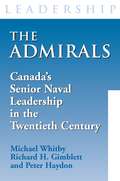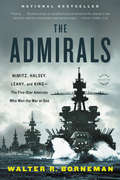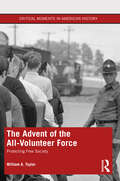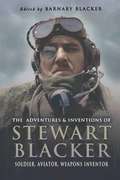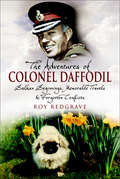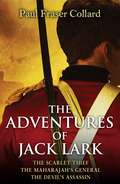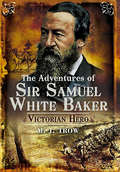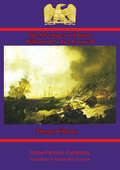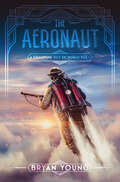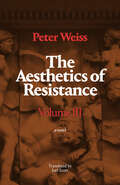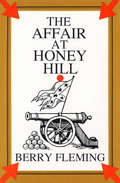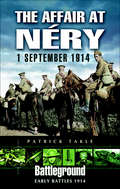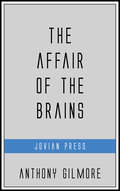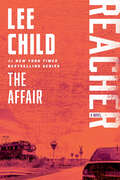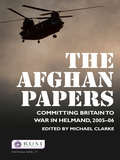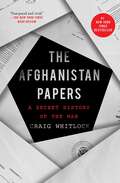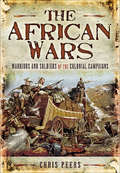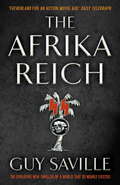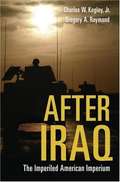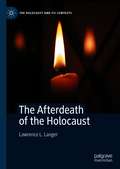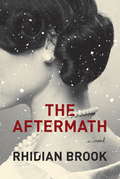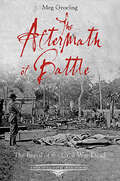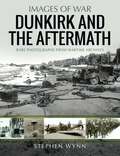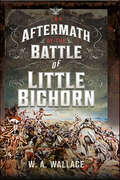- Table View
- List View
The Admirals: Canada's Senior Naval Leadership in the Twentieth Century
by Michael Whitby Richard H. Gimblett Peter HaydonThe Admirals: Canada’s Senior Naval Leadership in the Twentieth Century fills an important void in the history of Canada’s navy. Those who carry the burden of high command have a critical niche in not only guiding the day-to-day concerns of running an armed service but in ensuring that it is ready to face the challenges of the future. Canada’s leading naval historians present analytical articles on the officers who led the navy from its foundation in 1910 to the unification in 1968. Six former Maritime Commanders provide personal reflections on command. The result is a valuable biographical compendium for anyone interested in the history of the Canadian Navy, the Canadian Forces, or military and naval leadership in general.
The Admirals: Nimitz, Halsey, Leahy, and King--The Five-Star Admirals Who Won the War at Sea
by Walter R. BornemanHow history's only five-star admirals triumphed in World War II and made the United States the world's dominant sea power. Only four men in American history have been promoted to the five-star rank of Admiral of the Fleet: William Leahy, Ernest King, Chester Nimitz, and William Halsey. These four men were the best and the brightest the navy produced, and together they led the U. S. navy to victory in World War II, establishing the United States as the world's greatest fleet. In THE ADMIRALS, award-winning historian Walter R. Borneman tells their story in full detail for the first time. Drawing upon journals, ship logs, and other primary sources, he brings an incredible historical moment to life, showing us how the four admirals revolutionized naval warfare forever with submarines and aircraft carriers, and how these men-who were both friends and rivals-worked together to ensure that the Axis fleets lay destroyed on the ocean floor at the end of World War II.
The Advent of the All-Volunteer Force: Protecting Free Society (Critical Moments in American History)
by William A. TaylorThis book examines the extensive influence of the All-Volunteer Force (AVF) on the past, present, and future of America, demonstrating how the AVF encompasses the most significant issues of military history and defense policy. Throughout the vast majority of its wars during the twentieth century, the United States relied on a mixture of volunteers who chose to serve and conscripts provided through the Selective Service System, known colloquially as the draft. When the United States emerged as a world superpower in the aftermath of World War II, U.S. policymakers also depended on the draft during peacetime. Drawing on primary source documents, this book guides readers through the transition from the draft to the AVF and analyzes its history, results, challenges, and implications. Each chapter provides an overview of the issues of the time, recounts the ensuing debates and developments around them, and examines how they manifested themselves relative to the advent of the AVF and American society during times of peace and war. Combining narrative with documents, The Advent of the All-Volunteer Force is a valuable resource for students, scholars, policymakers, and general readers interested in modern American history, military history, and the dynamic linkages between policy, politics, and American society.
The Adventures and Inventions of Stewart Blacker: Soldier, Aviator, Weapons Inventor
by Barnaby BlackerStewart Blacker was a remarkable figure. His inventions were used with significant effect both in WW1 and WW2. Most notable of these was the synchronised machine gun, attached to fighter planes that could fire through the propeller. He also designed the PIAT anti tank weapon which was used with dramatic effect during WW2, from Normandy until the end of the war. The book argues that with less obstruction from officialdom, the PIAT could have been ready at the start of the war to stop Blitzkreig in its tracks.As an aviation pioneer, flying (and crashing) planes soon after the Wright Brothers, he found himself in charge his Majestys Air Force at the outset of WW1. Later after having seen the awful slaughter occurring in the trenches and feeling guilty he had chosen the easy option, he joined up with his old regiment and fought at Neuve Chapelle until he was injured in 1917. During the interwar years he continued to fly and develop weapons and was the first man to fly over the top of Everest.
The Adventures of Arabella Ashby: Arabella of Mars, Arabella and the Battle of Venus, and Arabella the Traitor of Mars (The Adventures of Arabella Ashby)
by David D. LevineFollow the nineteenth-century interplanetary adventures of a fearless steampunk space warrior in this full-trilogy collection. A teenage girl enters the fray of the Napoleonic Wars in space in this enthralling series &“for young and young-at-heart readers who will enjoy a retro-flavored science fiction read&” (Fantasy Literature). This complete collection includes: Arabella of Mars Forced by her mother to enter London society on Earth, sixteen-year-old Arabella must disguise herself as a boy to gain passage on an airship and foil a deadly plot against her brother back on her home planet of Mars. Arabella and the Battle of Venus When her fiancé is taken as a prisoner of war on Venus—the very planet where the exiled Napoleon has fled—Arabella embarks on a spacefaring rescue mission filled with pirates, espionage, and cosmic combat. Arabella the Traitor of Mars Arabella and her husband are lauded as heroes in England, having defeated Napoleon at the Battle of Venus. But a new mission will pit Arabella&’s love and loyalty for her home planet of Mars against the most powerful realm in the universe. Praise for the Adventures of Arabella Ashby trilogy &“If Edgar Rice Burroughs, Jules Verne, and Patrick O&’Brien had sat down together to compose a tale to amuse Jane Austen, the result might be Arabella of Mars. So. Much. Fun!&” —Madeleine E. Robins, author of the Sarah Tolerance Regency mysteries &“A fanciful romp through a cosmic 1812 . . . A treat for steampunk fantasy fans.&” —Library Journal (starred review)
The Adventures of Colonel Daffodil
by Roy RedgraveMajor General Sir Roy Redgrave has enjoyed an unusual, some might say eccentric, life. Born into the same family as the well known actors, he was brought up in Romania as part of a thriving international community before he joined the British Army and advanced to high rank.Following on from the success of his memoir Balkan Blue the author has pulled together a superb pot pourri of anecdotes covering his family, his military career and post-retirement travels and experiences. Readers will delight in the scope of this book which ranges widely from aristocratic life in feudal Romania to the dangers an intrigue of the Cold War; from the charm of French rural life to Franz Josef Land and encounters with polar bears, walruses and seals. We travel with this intrepid man from Kathmandu to Lhasa where he lived with impoverished Tibetans whose generosity and friendliness made the discomfort of primitive living at such altitudes disappear.These and other extraordinary experiences made this a fascinating read.
The Adventures of Jack Lark: the Jack Lark omnibus
by Paul Fraser CollardThe first three Victorian military adventures featuring hero Jack Lark, now available together in ebook. If you love Bernard Cornwell's Sharpe series, Matthew Harffy and Patrick O'Brian, you won't want to miss Paul Fraser Collard's action-packed series.INTRODUCING ROGUISH HERO JACK LARK: SOLDIER, LEADER, IMPOSTER.'Brilliant' BERNARD CORNWELL'Once again, Paul Fraser Collard proves he is a true master of action adventure' MATTHEW HARFFY'Like all the best vintages Jack Lark has aged to perfection. Scarred, battered and bloody, his story continues to enthral' ANTHONY RICHES_________THE SCARLET THIEFCrimean Peninsula, 1854. The men of the King's Royal Fusiliers are in terrible trouble. Young officer Jack Lark has to act immediately and decisively. His life and the success of the campaign depend on it. But does he have the mettle, the officer qualities that are the life blood of the British Army?From a poor background in London's East End, Lark has risen through the ranks by stealth and guile and now he faces the ultimate test...THE MAHARAJAH'S GENERALBombay, 1856. Jack Lark barely survived the Battle of the Alma. In hospital, wounded, and with his stolen life left lying on the battlefield, he grasps a chance to prove himself a leader once more. Poor Captain Danbury is dead, but Jack will travel to his new regiment in India, under his name.Exposed as a fraud, he's rescued by the chaplain's beautiful daughter, who has her own reasons to escape. They seek desperate refuge with the Maharajah of Sawadh, the charismatic leader whom the British Army must subdue. And, in return for his safety, Jack finds he must train the very army the British may soon have to fight...THE DEVIL'S ASSASSINBombay, 1857. Jack Lark is living precariously as an officer when his heroic but fraudulent past is discovered by the Devil - Major Ballard, the army's intelligence officer. Ballard is gathering a web of information to defend the British Empire, and he needs a man like Jack on his side. Not far away, in Persia, the Shah is moving against British territory and, with the Russians whispering in his ear, seeks to conquer the crucial city of Herat. As the British march to war, Jack learns that secrets crucial to the campaign's success are leaking into their enemies' hands. Ballard has brought him to the battlefield to end a spy's deceit. But who is the traitor?_________READERS LOVE THE JACK LARK SERIES:'Jack Lark is one of my favourite literary creations' 5* Reader Review'Up there with the best of the genre' 5* Reader Review'Collard's development of Lark is brilliant' 5* Reader Review'This truly is edge of the seat writing' 5* Reader Review'A breathless, memorable read and I recommend it completely' 5* Reader Review'SO good. Redcoats, gunpowder, and the horror of battle. Anyone who read Sharpe should devour this . . . A masterclass of grit and determination' 5* Reader Review'WOW. This is a very fast paced story that I found incredibly difficult to put down . . . If you like Victorian novels especially military ones, this series is definitely for you' 5* Reader Review
The Adventures of Sir Samuel White Baker: Victorian Hero
by M. J. TrowSir Samuel White Baker is one of those larger-than-life heroes only the Victorians could invent. For too long, the British Empire has been denigrated and equated with arrogance at best and racial bigotry at worst. Samuel Baker transcends that. He was an explorer and naturalist, recording new species on his many travels; a big game hunter with huge expertise across continents; an engineer of skill and ingenuity; a general of ability; an administrator second to none; and an ardent opponent of African slavery. M. J. Trow, in this the first biography of Baker for twenty years, draws heavily on Bakers prolific writings to bring the extraordinary character of this Victorian adventurer and his achievements to life.
The Adventures of Thomas Williams of St. Ives, Cornwall: A Prisoner Of War In France, 1804-1814 (1901)
by Thomas WilliamsThis ebook is purpose built and is proof-read and re-type set from the original to provide an outstanding experience of reflowing text for an ebook reader. An oft-forgotten number of British sailors, soldiers and merchantmen were taken prisoner during the long years of the Napoleonic Wars. Ranging from men such as Captain Moyle Sherer, who was captured in 1813, suffering less than a year of imprisonment, to Thomas Williams, who was captured only a year into the conflict. Thomas Williams was a sailor on a merchant ship and was captured after his ship lost its convoy en route to England. Williams left his memoir of his ten years in French captivity: ranging from mistreatment at the hands of his captors to his numerous escape attempts and the various characters he fell in with. A witty reminiscence on what was clearly a dark time for him, enlivened by a good sense of humour. Title - The Adventures of Thomas Williams of St. Ives, Cornwall Sub-Title - Who was a Prisoner of War in France from March 1804 to May 1814. Author -- Thomas Williams (1787-1862) Text taken, whole and complete, from the edition published in 1901, London, by Brentford Printing & Publishing Co. Original - 88 pages. Illustrations -- 3 Illustrations.
The Aeronaut: A Steampunk Tale of World War I
by Bryan YoungAn American soldier in WWI France flies a jetpack over no man&’s land in this steampunk historical adventure of action, espionage, and romance. At the beginning of the twentieth century, Europe is in the grip of bitter and bloody war. Computational machinery has allowed great technological leaps on both sides—making trench warfare even deadlier for soldiers at the front. Some men fight to defend their homeland. But Robert Preston flees America and joins the French Army to escape heartbreak. Placed in the elite 5th Aeronautic Corps, he learns to use high-tech jetpacks to leap over trenches—and the deadly no man&’s land between them. It&’s a dangerous job with a low survival rate, but Preston is determined to make a difference. There, he meets a man he calls his best friend, and a woman he believes is the love of his life. But a top-secret mission behind enemy lines, and a heart full of jealousy, threatens to tear the three of them apart forever.
The Aesthetics of Resistance, Volume III: A Novel, Volume 3
by Peter WeissA major literary event, the publication of the final volume of Peter Weiss’s three-volume novel The Aesthetics of Resistance makes one of the towering works of twentieth-century German literature available to English-speaking readers for the first time. Weiss’s crowning achievement, The Aesthetics of Resistance spans the period from the late 1930s to the end of World War II, dramatizing antifascist resistance and the rise and fall of proletarian political parties in Europe.Volume III, initially published in 1981, teems with characters, many of whom are based on historical figures. It commences in May of 1940, as the narrator’s parents flee Nazi forces in Eastern Europe and reunite with their son in Sweden. While in Stockholm, the narrator and other Communist activists living in exile struggle to build structures in the German underground. The story then follows Communist resistance fighter Charlotte Bischoff as she is smuggled to Bremen on a freighter. In Berlin, she contacts the narrator’s friends and joins the Red Orchestra resistance group. Soon, the Gestapo cracks the underground group’s code, arrests a number of its members, and takes them to Plötzensee Prison, where most of them are executed. Featuring the narrator’s meditations on paintings, sculpture, and literature throughout, The Aesthetics of Resistance demonstrates the affinity between political resistance and art. Ultimately, Weiss argues that we must look to art for new models of political action and social understanding.
The Affair at Honey Hill
by Berry FlemingWhile Berry Fleming's interest in history has produced two books of non-fiction, one of which dealt with the Civil War (Autobiography of a City in Arms), The Affair at Honey Hill marks the first time he has used the Civil War as a setting for any of his novels. The story is presented through the eyes of Edwin Daws, a 56 year old Confederate soldier, from his present day (winter, 1864) awareness, as well as his memories, both recent and past. Assigned with his militia company, The Silver Grays, to repel an assault on the railroad leading into Savannah near Honey Hill Plantation, he recalls the month he spent there 18 years earlier, working as a scribe for the Reverend Trezevant Ferebee, and of his growing love for the Reverend's enigmatic daughter-in-law, Julia. What is to become of them now with Sherman's forces moving fast to attack the city? Where is Julia? Can he find her in all this desperate confusion and extricate her? The Affair at Honey Hill is a tight and graphic narrative of human beings--civilians and soldiers--caught in the stress of war and defeat, ripe with the sounds and smells and textures of loves and battles, of opportunities lost and gained, and of hard moral decisions.
The Affair at Néry: 1 September 1914 (Battleground Early Battles 1914)
by Patrick TakleEarly on 1 September 1914, the Germans surprised 1st Cavalry Brigade harboring in the little town of Nry. Their initial bombardment caused chaos and destruction and the British took time to organize themselves. The actions of two batteries of the Royal Horse Artillery were eventually so successful that even today there is a battery known as Nry Battery RHA. The Queens Bays a cavalry regiment, charged in classic style and the Germans, who mistakenly thought they were out numbered, withdrew with heavy casualties.Of the three VCs, two were posthumous.While a small engagement by later Great War standards, Nry is a classic case study of an artillery duel and cavalry action.
The Affair of the Brains
by Anthony GilmoreHawk Carse himself goes to keep Judd the Kite's rendezvous with the sinister genius Ku Sui.
The Affair: A Jack Reacher Novel (Jack Reacher #16)
by Lee Child#1 NEW YORK TIMES BESTSELLER • Don&’t miss the hit streaming series Reacher! &“A veritable tour de force . . . brilliantly executed and deliciously plotted.&”—The Washington TimesEverything starts somewhere. For elite military cop Jack Reacher, that somewhere was Carter Crossing, Mississippi, way back in 1997. Reacher is ordered undercover to investigate the murder of a young woman. Evidence points to a U.S. soldier with powerful friends. Once in Carter Crossing, Reacher meets local sheriff Elizabeth Deveraux, who has a thirst for justice and an appetite for secrets. Uncertain they can trust each other, they reluctantly join forces. Reacher works to uncover the truth, while others try to bury it forever. The conspiracy threatens to shatter his faith in his mission— and turn him into a man to be feared.
The Afghan Papers: Committing Britain to War in Helmand, 2005–06 (Whitehall Papers #Vol. 77)
by Michael ClarkeIn 2006, British forces entered the Helmand Province of Afghanistan in what would become one of the defining military campaigns of the decade. At great cost in blood and treasure, the UK waged a protracted counter-insurgency against a resurgent Taliban. But how was the decision taken to commit Britain to such a difficult and drawn out campaign? The Afghan Papers is the result of private interviews with and frank contributions by some of the most important actors in the fateful decision. Former generals, politicians and civil servants contribute to an original RUSI analysis that provides a startling insight into the decision to commit the UK to a war – a decision wracked by conflict, incoherence and confusion.
The Afghanistan Papers: A Secret History of the War
by The Washington Post Craig WhitlockA Washington Post Best Book of 2021 The #1 New York Times bestselling investigative story of how three successive presidents and their military commanders deceived the public year after year about America&’s longest war, foreshadowing the Taliban&’s recapture of Afghanistan, by Washington Post reporter and three-time Pulitzer Prize finalist Craig Whitlock.Unlike the wars in Vietnam and Iraq, the US invasion of Afghanistan in 2001 had near-unanimous public support. At first, the goals were straightforward and clear: defeat al-Qaeda and prevent a repeat of 9/11. Yet soon after the United States and its allies removed the Taliban from power, the mission veered off course and US officials lost sight of their original objectives. Distracted by the war in Iraq, the US military become mired in an unwinnable guerrilla conflict in a country it did not understand. But no president wanted to admit failure, especially in a war that began as a just cause. Instead, the Bush, Obama, and Trump administrations sent more and more troops to Afghanistan and repeatedly said they were making progress, even though they knew there was no realistic prospect for an outright victory. Just as the Pentagon Papers changed the public&’s understanding of Vietnam, The Afghanistan Papers contains &“fast-paced and vivid&” (The New York Times Book Review) revelation after revelation from people who played a direct role in the war from leaders in the White House and the Pentagon to soldiers and aid workers on the front lines. In unvarnished language, they admit that the US government&’s strategies were a mess, that the nation-building project was a colossal failure, and that drugs and corruption gained a stranglehold over their allies in the Afghan government. All told, the account is based on interviews with more than 1,000 people who knew that the US government was presenting a distorted, and sometimes entirely fabricated, version of the facts on the ground. Documents unearthed by The Washington Post reveal that President Bush didn&’t know the name of his Afghanistan war commander—and didn&’t want to meet with him. Secretary of Defense Donald Rumsfeld admitted that he had &“no visibility into who the bad guys are.&” His successor, Robert Gates, said: &“We didn&’t know jack shit about al-Qaeda.&” The Afghanistan Papers is a &“searing indictment of the deceit, blunders, and hubris of senior military and civilian officials&” (Tom Bowman, NRP Pentagon Correspondent) that will supercharge a long-overdue reckoning over what went wrong and forever change the way the conflict is remembered.
The African Wars: Warriors and Soldiers of the Colonial Campaigns
by Chris PeersA military history of native sub-Saharan African armies during the late nineteenth and early twentieth centuries, exploring their training, weapons, tactics and more.In The African Wars, Chris Peers provides a graphic account of several of the key campaigns fought between European powers and the native peoples of tropical and sub-tropical Africa in the late nineteenth and early twentieth centuries. His pioneering and authoritative study describes in vivid detail the organization and training of African warriors, their weapons, their fighting methods and traditions, and their tactics. He concentrates on the campaigns mounted by the most successful African armies as they struggled to defend themselves against the European scramble for Africa. Resistance was inconsistent, but some warlike peoples fought long and hard—the Zulu victory over the British at Isandhlwana is the best known but by no means the only occasion when the Africans humiliated the colonial invaders.
The Afrika Reich: A Novel
by Guy SavilleWhat if Dunkirk had been the end of Britain's war against the Nazis?'Fatherland for an action movie age.' Daily Telegraph1952. It is more than a decade since humiliation at Dunkirk brought an end to Britain's war and the beginning of an uneasy peace with Hitler.In Africa, the swastika flies from the Sahara to the Indian Ocean. Gleaming autobahns bisect the jungle, jet fighters patrol the skies. The brutal presence of the SS is visible everywhere. Now, however, the demonic plans of Walter Hochburg - architect of Nazi Africa - threaten Britain's ailing colonies.In England, ex-mercenary Burton Cole is offered one last contract. Burton jumps at the chance to settle an old score with Hochburg, despite the protests of the woman he loves. If Burton fails, unimaginable horrors will be unleashed in Africa. No one - black or white - will be spared.But when his mission turns to disaster, Burton is forced to flee for his life. His flight takes him from the unholy killing ground of Kongo to SS slave camps and on to war-torn Angola, finally reaching its thrilling climax in a conspiracy that leads to the dark heart of the Afrika Reich itself.Guy Saville combines meticulous research with edge-of-the seat suspense to produce a superb novel of alternate history.
The After Iraq: The Imperiled American Imperium
by Charles W. Kegley Gregory A. RaymondAs the year 2001 unfolded, the United States stood at the apex of global power, possessing unrivaled military capabilities, a vibrant economy, and-most of all-great self-confidence in its sense of national security. However, after the terrorist attacks of 9/11 shattered those illusions of invincibility, the world's sole superpower embarked on a revolutionary new national strategy based on preventive uses of military force. Although this aggressive approach was formulated to enhance U.S. security, it has actually created new perils for the next generation of Americans.
The Afterdeath of the Holocaust (The Holocaust and its Contexts)
by Lawrence L. LangerThis book consists of ten essays that examine the ways in which language has been used to evoke what Lawrence L. Langer calls the ‘deathscape’ and the ‘hopescape’ of the Holocaust. The chapters in this collection probe the diverse impacts that site visits, memoirs, survivor testimonies, psychological studies, literature and art have on our response to the atrocities committed by the Germans during World War II. Langer also considers the misunderstandings caused by erroneous, embellished and sentimental accounts of the catastrophe, and explores some reasons why they continue to enter public and printed discourse with such ease.
The Aftermath
by Rhidian BrookHamburg, 1946. Thousands remain displaced in what is now the British Occupied Zone. Charged with overseeing the rebuilding of this devastated city and the de-Nazification of its defeated people, Colonel Lewis Morgan is requisitioned a fine house on the banks of the Elbe, where he will be joined by his grieving wife, Rachael, and only remaining son, Edmund. But rather than force its owners, a German widower and his traumatized daughter, to leave their home, Lewis insists that the two families live together. In this charged and claustrophobic atmosphere all must confront their true selves as enmity and grief give way to passion and betrayal. The Aftermath is a stunning novel about our fiercest loyalties, our deepest desires and the transformative power of forgiveness.
The Aftermath of Battle: The Burial of the Civil War Dead (Emerging Civil War Series)
by Meg GroelingThe stories of what happened after the shooting stopped and the process of burying bodies in the wake of Civil War carnage and chaos.The clash of armies in the American Civil War left hundreds of thousands of men dead, wounded, or permanently damaged. Skirmishes and battles could result in casualty numbers as low as one or two and as high as tens of thousands. The carnage of the battlefield left a lasting impression on those who experienced or viewed it, but in most cases the armies quickly moved on to meet again at another time and place. When the dust settled and the living armies moved on, what happened to the dead left behind? Unlike battle narratives, The Aftermath of Battle picks up the story as the battle ends.The burial of the dead was an overwhelming experience for the armies or communities forced to clean up after the destruction of battle. In the short-term action, bodies were hastily buried to avoid the stench and the horrific health concerns of massive death; in the long-term, families struggled to reclaim loved ones and properly reinter them in established cemeteries.Visitors to a battlefield often wonder what happened to the dead once the battle was over. This compelling, easy-to-read overview, enhanced with extensive photos and illustrations, provides a look at the aftermath of battle and the process of burying the Civil War dead.
The Aftermath of Dunkirk: Rare Photographs from Wartime Archives (Images of War)
by Stephen WynnOperation Dynamo, the successful evacuation of Belgian, British, Dutch, French and Polish troops from the beaches at Dunkirk between 27 May and 4 June 1940, was not only a pivotal moment of the war, but one that changed its final outcome. There has been much debate in the years since the end of the war concerning the “Hitler Halt” order, which was given to German Panzer units waiting patiently on the outskirts of Dunkirk to be allowed to finish the job they had started. Many theories have been put forward as to the reasons behind this, but the consequence was that it allowed Britain to remain in the war. A total of 338,226, British and Allied troops were rescued from the beaches of Dunkirk, aboard a total of 861 vessels, of which 243 were sunk. For those left behind, official figures record that up to 80,000 French and British troops were captured, whilst during the time of the actual evacuation, somewhere in the region of 16,000 French and 1,000 British soldiers were killed. Equipment wise British forces left behind somewhere in the region of 90,000 rifles, 11,000 machine guns, huge supplies of ammunition, 880 field guns, 310 large calibre artillery pieces, 500 anti-aircraft guns, 850 anti-tank guns, 700 tanks, 45,000 cars and lorries, and 20,000 motor cycles – enough equipment to arm nearly ten divisions of soldiers. It is known that two atrocities took place during the Battle of Dunkirk: the Massacre at Le Paradis, and another at Wormhoudt, carried out by Waffen- SS soldiers, against British and French troops who had already surrendered. Although the Battle of Dunkirk must ultimately go down tactically as a German victory, the rescue of so many of its men, ensured that like a phoenix, Britain rose from the ashes of defeat to gain a great and lasting victory.
The Aftermath of the Battle of Little Bighorn
by W.A. WallaceThe second volume, Wallace's work seeks to shine light on the cover up of the murder conspiracy of Generals Sheridan and Sherman to kill G. A. Custer, as well as go over the aftermath of the battle itself and the resulting Reno Court of Inquiry. Lt. Col. George Armstrong Custer died at the hands of Native Americans by the banks of the Little Bighorn in Montana 25th June 1876. This is an established undisputed fact. What is disputed is the real reason that he died. So forget all you have been led to believe and begin to learn the truth. George Custer was anathema to his superiors, but the populace loved him. If he were to stand for president in the coming elections there was a strong possibility that he would win. Neither William T. Sherman nor ‘Little Phil’ Sheridan could allow that to happen. Thus, they conspired to put Custer in a position in the field where the opposing Sioux and Cheyenne were stronger and could deliver the ‘Coup de Gras’. This is the second of two books dealing with the circumstances that arose leading the Native Americans on a collision course with the US Army that fateful day and the death of a national hero. Subsequently the conspiracy is uncovered and shows how these men used their powers and positions and so deftly covered their tracks. Perhaps, but not quite. 30 years of diligent research has uncovered the truth in this groundbreaking history. Unmissable and shocking, dare you not read this surprising revelation.
